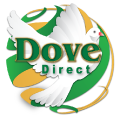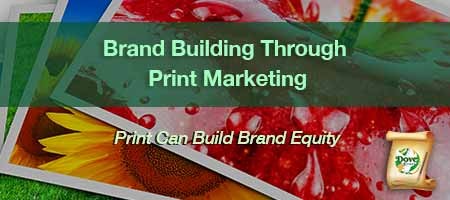Brand Building Through Print Marketing
Our Quote of the Day:
"I hated every minute of training, but I said, don't quit. Suffer now and live the rest of your life as a champion." — Muhammad Ali
The Law of Brand Consistency
Brands require time to build momentum. Most measure successful branding in decades, not years. Remember when the Apple Macintosh hit the public consciousness in 1984 with its iconic ad depicting a woman crashing corporate glass. At the time, the spot directed by Ridley Scott was a groundbreaking masterpiece. The concept behind the commercial inferred that Macintosh would revolutionize personal computing by saving humanity from conformity, an apparent swipe at IBM, the dominant computing juggernaut at the time. That message proved highly effective and helped catapult the Mac and its subsequent product lines to its current position as one of the big five American information technology companies. Steve Jobs did not stop there. He built the brand on people's needs and expectations. Today, Apple has the distinction as the world's most valuable company.
The consistency factor in Apples' case is the continuation of product development, including creating new categories, such as the iPod, iPhone, iPad, wearables, accessories, and services. These new categories enable the company to hold a leadership position globally.
The second consistency factor involves Apple marketing strategies whereby all go-to-market products feature seamless creativity, applicable for both traditional and online mediums. The annual September Live Event is a mainstay in Apple's arsenal of communication strategies and, as a result, has contributed heavily to Apples' ascendance as a trillion-dollar organization.
The lesson is to remain consistent throughout the brand-building journey. Even when sales may be challenging, staying in front of the public's eye is a requirement if you intend to build brand equity and brand visibility. Today, Apple's marketing consists of traditional media and live events delivered consistently. According to the 22 Immutable Laws of Branding by Al and Laura Reis, The Law of Consistency is the one that marketers violate most frequently. The duo says that once a brand stands for something, it is often abandoned, as the manufacturer initiates a "change the brand" mentality. The problem is that markets will change, but brands should not. It's okay to change the content or incorporate a new slant; however, the essential characteristics that propelled brand mindshare should never change. It's a lesson that Apple has perfected in terms of product development and marketing.
Building the Brand
The daily marketing bombardment of over 10,000 messages in multiple mediums, including emails, texts, feeds, social media, television, radio, and more, is overwhelming. Brands have a very challenging task to be noticed by consumers. To break through the clutter, one needs to apply the law of consistency and brand the company daily.
One only needs to consider the initial benefits of branding:
- Brands can be recognized, regardless of language
- Brands typically last longer than product cycles
- Brands provide cohesive components across all marketing mediums
- Brands promote quality and trust while offering experiences
- Brands can sever the organization from competitive landscapes
- Brands can direct and motivate staff
- Brands bring about customer referrals
- Brands connect on an emotional level with consumers and customers
- Brands invoke value for the organization at large
The art of branding supersedes that of the logo. Branding embraces the entire customer experience, which goes to the heart of how people perceive the brand. Regardless of the industry sector, brands can differentiate themselves from the competition.
Industries that Benefit from Cohesive Branding Campaigns
Certain industries, more than others, benefit from cohesive branding campaigns. Those that engage print and digital include:
- Service and Business Industries: Regardless of the brand being in hospitality or retail and offering goods or services, communications need to be delivered to a target group of consumers that details the company.
- Healthcare: Healthcare is an ever-changing industry that delivers constant messaging to providers, insurance organizations, and patients.
- Insurance Carriers: Insurance carriers are constantly changing rates underwriting plans, with various payout terms that need to be continually updated, educated, and communicated with consumers and stakeholders.
- Financial Services: This industry must continually exchange communications with stakeholders, investors, and the general public.
- Agencies and Franchises: This sector is responsible for keeping mindshare top of mind to ensure that consumers can buy via print marketing initiatives when they are ready to purchase.
- Colleges and Universities: Targeted direct mail campaigns help the educational sector discover student prospects' fundraising opportunities and maintain contact with Alumni.
Branding with Print Marketing
Print marketing is a great place to craft a branding campaign. Print marketing collateral can sell products and services while elevating the organization's image. Specifically, brands should consistently apply the company logo, tagline, and color pallet across channels when using print marketing. The trick is to size the logo correctly and ensure that the remaining marketing components are consistent. Always ensure that specific brand elements offer a sameness anywhere and everywhere when displayed as media elements. Consistent branding builds brand recognition in the marketplace.
Print also affords opportunities to diverge with texture, paper, and additional elements that make it unique to the print environment. The more engaging the creative is, the more likely it will capture attention and deliver lasting impressions for the target audiences.
The following list suggests ways to incorporate print marketing through branding:
- Business Cards, Letterhead, Brochures, Folders, Envelopes, and Flyers
- Direct mail campaigns that use letters, catalogs, postcards, transpromotional, transactional statements, as well as e-statements
- Press Releases on company letterhead
- Promotional items that range from hats, cups, pans, cups, bottles, notepads, and calendars
- Pop-up banners, backdrops, programs, and posters for hybrid or live events
- Employee apparel that features the color palette, logo, tagline, and marketing messages
The Net-Net
The necessity for branding is as fundamental as the offering itself. Branding is not pie in the sky, feel-good pop-ups, instead it is a basic requirement. Branding is the essential makeup of any organization, and through print marketing, the brand remains consistent and tangible. Additionally, competitors acquired Cadbury and Range Rover because of their brand equity. Thanks for reading "Brand Building Through Print Marketing!"
Let's have a conversation about integrated business solutions and how they can help grow your business, change behavior, and improve the customer experience. Let us show you how to improve your document processes to optimize your workflow, reduce costs, and maximize your organization's printing, letter shop, and mailing capabilities. Dove Direct does have an official USPS certified bureau located within our offices that will save you time and money. We can even create a demo file for you. For more information, call Carla Eubanks at 404-629-0122 or email Carla at This email address is being protected from spambots. You need JavaScript enabled to view it..
Dove Direct, your Atlanta based print and mail solutions provider, offers organizations end-to-end data, printing, and mailing solutions:
- Data Management
- Variable Digital/Data Printing
- LetterShop and Fulfillment
- Digital Mail Scanning Services
- Fully Automated MLOCR Presort Bureau
- Marketing and Production Management Support
- Secure Data Life Cycle Management
If you don't want to wait, you can reach Dove Direct today by calling 404-629-0122 or using the Contact Form for Dove Direct.





